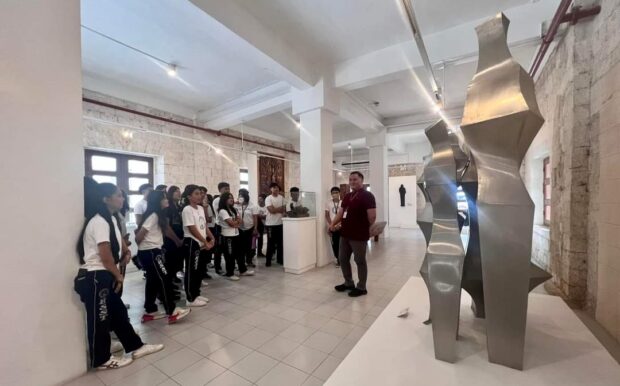
Students marvel at the artistic legacy of Bohol’s cherished National Artist for Sculpture, Napoleon Veloso Abueva, at the National Museum of the Philippines-Bohol. (Photo courtesy of the National Museum of the Philippines-Bohol)
TAGBILARAN CITY — The National Museum of Philippines (NMP) will officially launch on Wednesday its newest exhibition entitled, “Paglawig (Journey): The Boholano Way of Life.”
The exhibition highlights artifacts and ecofacts recovered by the NMP in the 1980s in the towns of Anda, Mabini, Candijay, and Guindulman.
These sites proved the use of stones, shells, and bones as tools and ornaments of the early Boholanos, said NMP in a statement.
“The use of dug-out wooden coffins and burial jars as well as the offering of local and tradeware ceramics further illustrated their technological knowledge and rituals,” it said.
Tracing the journey of the Boholanos before the colonization era to the present, this exhibition provides an overview of their traditional crafts such as boat-building, fishing, farming, metalsmithing and jewelry making, basket and “raffia” weaving, and the production of “asin tibuok” (artisanal sea salt).
Local technologies used in these occupations reflect significant aspects of Boholano’s past and current way of life in terms of their technical choices, community organization, skills specialization, trade relations, style and design preferences, ecological knowledge, and symbolisms, among others.
Part of the exhibition highlights some of the past technologies that persist in the different communities such as “bigiw-making” in Cortes; “ku’n-making” in Alburquerque; and metal blade production in Sikatuna.
A special section features the asin tibuok of the southern coastal town of Alburquerque.
Asin (salt), NMP said, was one of the most important commodities in early lowland highland trade in the Visayan region and was exchanged for humay (unmilled rice) and cotton from inland communities.
Today, the Kapunungan sa Mang-Asinay sa Alburquerque, a local salt makers cooperative, continues the traditional production and knowledge transmission of the asin tibuok.
The NMP said the gallery will be officially opened to the public on June 1. Admission is free and no vaccination cards are required.
READ:
National Museum reopens after Bongbong Marcos oath taking
DOT to include National Museum in tourism circuits